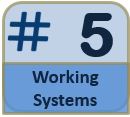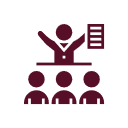SAFe - Scaled Agile Framework for Lean Enterprises, is an Agile framework that takes a more lean approach to Product Development. Learn about the ART (Agile Release trains) and PI planning techniques, as well how the business vision is aligned to the enterprise delivery.
Scaled Agile Framework (for Lean) Enterprises (SAFe)
Some of the criticisms associated to Scrum is that it is not scaleable, also the alignment to the business strategy and vision is non-aligned. SAFe (Scaled Agile Framework for Lean enterprises) introduces a lean appraoch towards scaleabiltiy that is transparent at all levels in the organisation. The mindset is based on core competencies, pillars, principles and the Agile manifesto.
SAFe focuses on the core competencies and SAFe principles in order to provide guidance on the mindset instilled for the SAFe journey. Where this is different from other Agile frameworks is that it takes the principles of Lean to adopt the Lean-Agile approach.

Core Values
As a member of the SAFe team the mindset is towards the core 4 values and guides them through some of their responsibilities.

Its important that all solution teams and stakeholders are able to visualise the work to be completed, where they are and if there are any impediments in the process. Trust and honesty is paramount in this so teams have core values such as admitting their mistakes without apportioning blame and learn from them.
Ensuring the build software is visible to others and includes metrics to demonstrate the progress and control as well as flow is important, for example Program, Kanban boards and system demos.

In SAFe quality is never compromised and is built into the product, this is a pre-requisite step. All aspects of the build should ensure quality including the techniques used to build it, if there is any re-work of code or functionality this will result in the flow being interupted hence business value will be compromised.
Integration is also an objective for quality, using techniques such as test driven development (tdd) or behavourial driven development (bdd) and automated testing. Continuous integration is also an important factor, infact integrating code early and frequently as possible is a must.

Program execution is about delivering value to the solution at all levels of SAFe, and in doing so encompasses all the other values such as Transparency, Built in Quality and alignment. The objective for program execution is to have not only value but stability and there should be no bottlenecks or impediments.

The work done by the team should be aligned at every level of SAFe, at the highest level the business strategy is aligned to the portfolio. The Program increment (PI) planning objectives and iteration goals align the portfolio to the program level. The PI objectves align the rest of the SAFe team to the overall business strategy and how we going to get there. Also in SAFe cadence and synchronisation is used to ensure aignment between teams.
For alignment to work the vision and business strategy and high level objectives are understood by all, this is key to SAFe.
Core Competencies of Lean Enterprise
SAFe has five core competencies based on the Lean Enterprise. These competencies embodies the whole mindset for Agility. This competencies are highlighted below:

This competency addresses the mindset for leadership for executives and managers with the need to lead the transformation and driving the following concepts to the organisation:
- Lean Core competencies
- Agile Manifesto
- Agile principles
- House of Lean
- SAFe principles


This is based on 2 foundations, the first is the team agility this is based on the SAFe principles and values; the second is technical agility which focuses on the system releases and the quality of the product. For team agility the following agile principle is adopted:
Agile Principle #5 "..Build projects around motivated individuals. Give them the environment and support they need, and trust them to get the job done.."
The focus is on self organised, collaborative approach to agility adhering to the Agile concept of motivated individuals and trust them to get the job done. Team agililty focuses on the Built in Quality core values, so focus on good design, good architectural approach using technical concepts such as Continuous Integration, Extreme Programming and code quality reviews.

DevOps from a SAFe perspective is part of the culture to provide shared responsibility and accountability using a set of principles that are geared towards automation of coding, testing and release cycles. One of the main practices are Continuous Integration which is an Extreme Programming concept.
DevOps also incorporate Continuous Integration and Delivery, where the pipeline is scoped towards release on Demand. Its here the concept of Agile Release trains start during Continuous Exploration, Continuous Integration and Continuous Delivery and features as the Delivery pipeline.
This core competency helps us to conceptualise the Agile Release Train (ART), this is the whole teams exploring, building and deploying the business value as a flow.

When we talk about business Solutions we are focused around multiple Agile Release Trains (ART), and managing the build of small components, validating the hypothesis and then building out the features. Co-ordination of the various ARTs to ensure the integration of those components in to the business.
Compliance is also a key feature ensuring there is some governance to validate the business value, processes in the delivery.

This is the alignment of your enterprise strategy to your organisation (or portfolio). This encompasses three main pillars Strategy, Lean Governance and Agile Portfolio Operations. Portfolio canvas is introduced and The concept of identifying value streams that bring benefit to the customer are modelled here, and lean budgets to establish the flow at portfolio level which will resonate lower down the models.
House Of Lean
There are 5 main areas that form the components for House of Lean, and these contain midsets, guidance and tools to adopt each approach:

House of Lean was first introduced by Toyota, this was the philosophy behind lean thinking, a set of tools and practices that embodied the way Lean approach works and sits within the organisation. SAFe adopts a similar model and drives the behaviours of the organisation that uses SAFe.
The goal for the Lean approach is defined by Value the sustainable shortest lead time in order to reduce the waste or delay and give value to the business. The foundations for Lean is Leadership and between these there are four main pillars, Respect, flow, Innovation and Relentless improvement.

Value
sits on the roof of the organisation it delivers the maximum customer value in the shortest sustainable lead time and provide the highest quality. A SAFe organisation will embrace customer value in delivering its services or products and sees its customer as the main priority.

Respect for people and culture
SAFe recognises that its the culture and the people that are the most important factors in an organisation and particular the respect towards the workers or people. Trust is a strong driver for this, so trust the people on what they do and how they do it and without blame. Culture change is matured within the organisation where SAFe core values and principles will sit.

Flow
This can be described as "... the flow of customer Value and benefits" and the focus is in the Value stream. The flow is continously optimised to drive the maximum benefit and remove any impediments or blocker that my hinder the sustainability of flow. Quality within the flow should never be compromised and should be optimised using WIP limits, reducing batch sizes and queue lengths as well as eliminating delays in the process.

Innovation
This pillar focuses the organisation to use innovative techniques to stay ahead of the market to push products to the right limit. By adopting an innovative mindset will allow organisations to be ahead of the competition. Organisations are encouraged to use mentors or coaches to help support these changes and drive the creativity needed. Innovation should encourage workers to go in to the workplace to see how things are being done in order to understand what needs to be innovated.

Relentless Improvement
Pillar 4 is about adapting to the environment in pursuit of improvement in both the organisation and development. To improve relentlessly requires a depth of retrospection and reflection on most activities. Reflection involves honest and admit mistakes made without apportioning blame and a good level of collaborative problem solving skills.

Leadership
The foundation phase for the House of Lean underpins all the pillars for Leadership. Leadership is embraced from all parts of the organisation and are collective in there approach of the lean-agile mindset. Leaders are expected to promote lean-agile approach to everything they work on or do. There are two main principles that lock into Leadership - Decentralise decision making and Unlock the intrinsic motivation of knowledge workers.
SAFe Principles
SAFe has 9 principles that are based from Agile principles, Lean product development and systems thinking, each of these principles are embodied throughout the SAFe framework and are discussed below:

Take Economic View
SAFe encourages to take an economic view on decision making, by taking this approach greater value can be attained from the delivery. Value is delivered in the form a value streams and is delivered incrementally, with an 'Deliver early and often' approach. With incremental delivery fast feedback loops are incorporated so smaller sets of delivery have larger value than larger chunks.

Apply System Thinking
SAFe acknowledges the importance of system thinking in terms of architecture and design, a solid foundation of the systems working should exist to get into the mindset as to what has been built. This focus will allow the end to end understanding of the system and the expertise to optimise the value stream and reduce waste or delays in the process. Each component of the architecture needs to be understood in order to achieve this.

Assume variablilty; preserve options
Both analysis and design approach must be flexible from the offset, this is due to the emerging detail that comes transparent as the journey unfolds and the learning increases.
By creating options on the design process allows alternatives on approach as more is understood on the requirements or challenges. Each option or branch will have its own economic benefit but it allows an organisation to change if it needs to based on further understanding.

Build incrementally with fast, integrated learning cycles
Fast feedback is a pre-requisite in most agile frameworks, this allows better decision making as the solution evolves, by having integration points within the feedback mechanisms, learning cycles can then be incorporated to make the right choices. This approach reduces the risks and presents contigency that the development is on track and gives the organisation the maximum business value.

Base milestones on objective evaluations of working systems
Waterfall is based on phase gate milestones, this is where the analysis, design and build is tested before a demo is given to the users. SAFe takes a view that if we take a phase gate approach we compromise the value stream achieving its goal and delivering the right benefit.
By adding integration points with system demos allows a more economic benefit to be realised early and the right approach taken at the earliest point. The benefit of integration points on working systems facilitate learning towards optimal solutions.

Visualise and Limit WIP, reduce batch sizes, and manage queue lengths
This relates to Kanban and kanban metrics by forcing a pull system in the Kanban by setting work In progress limits (WIP) and applying Little'law we can do three of the following things:
- Visualise the workflow
- Limit work in Progress (WIP)
- Reduce batch sizes
- Manage Queue lengths

Apply cadence, synchronise with cross-domain planning
Cadence provides events in SAFe as a rhythmic pattern, a steady heartbeat of the process, such events are like ceremonies or meeting that become predictable as nature. By applying cadence allows planning and predictability thus reducing variance and allows integration points for inspection and transparency.
Synchronisation of events ensures that teams work in alignment with each other so that multiple events occur at the same time and aligns the business to the delivery. Both cadence and Synchronisation are working alongside each other help in shared activity of predictability. Synchronising with cross-domain planning is associated with PI planning.

Unlock the intrinsic motivation of knowledge workers
This principle focuses on giving more responsibility or autonomy to workers to make decisions without having to escalate them to higher levels and unlocks quality and productivity. Knowledge workers are deemed to be doing the work and should have the ability to make decisions and take responsibility on the approach. SAFe embraces and promotes the platform for Mutual Influence.

Decentralise decision-making
Lean thinking empowers decentralising decision making so that right people can make the right decision at the right time and not become a bottleneck to the flow. Delivering value to the shortest sustainable lead time requires the flow to be continuous waiting on decisions will only lead to waste or delays. The decision making process is broken down to empower teams to make strategic decisions and be responsible.
Agile Release Train
Agile Release trains (ART) are conceptual delivery vehicles made up of all the agile teams, personnel and stakeholders in the delivery of solutions. They run in each of the SAFe configurations and they deliver value through the Value stream of the organisation. Multiple Agile Release Trains can run delivering its own value stream and they continously deliver value. Each art is aligned to a single backlog.

Roles and Responsibilities
In SAFe there are specific roles associated for the configurations. These are described below:

- Scrum Master
- Product Owner
- Development Team
The Agile team is a cross functional team that is very similar to a scrum team, in that all the roles, ceremonies and artefacts are the same. The role of the scrum master is of a servant leader, the Product owner maintains the backlog and the development team build the increment.

- Release Train Engineer
- Solution Train Engineer
The Release Train Engineer (RTE) and the Solution Train Engineers (STE) are similar to a scrum master in that they are servant leaders for the Agile Release Train. They co-ordinate and run all ART events and are involved in all activities associated to the ART and works with all scrum masters and Product Owners and business owners with the objective for delivering value. They also act and serve as the Agile coach.

- System Architect
- Engineer
The system architect provides the architectural guidance and provisions to the engineering teams

- Product Management
The product management define the products and the epics that are to be built that drive the business value. The focus on the Program vision and strategy.

- Business Owners
The business owners are the main stakeholders that are responsible to provide the requirement and walkthroughs from a business perspective, and are often deemed as the main stakeholders in the Agile Release Train. They give clear governance and guidance on the business value for the solution.

- Enterprise Architect
The Enterprise Architect defines the architectural strategy for the organisation and focus on the strategic planning and alignment of the team towards the architectural runway. The promote the technical capabilities at Enterprise level.

- Epic Owners
The Epic owners are responsible for the epic level requirements that are aligned to the business strategy to align teams towards their delivery. They also help to align the high level business requirements to prioritise epic features and capabilities.
SAFe Configurations
There are four main configurations for SAFe. The configurations are lean representations on how organisations can adopt SAFe. At the lowest level we have essential SAFe, then program, Large Solution and finally Portfolio. The complete configuration is called Full SAFe.
The out-of-the-box configurations are a blueprint on all the roles, values, processes, ceremonies, artifacts and disciplines involved at any given level of SAFe. Its a visual representation of the transprency of how SAFe operates in the form of a 'big picture'.
1. Essential SAFe
This is the basic configuration and contains the minimal set of roles, events and artifacts needed for SAFe for an organisation to deliver at scale. The shape of the team is based on a Agile Scrum or Kanban team and to align these multiple teams towards a shared goal. Like scrum we have a backlog, a scrum master and a development team so for teams using scrum has a smoother transition than ones that are not.
Although a basic model it does contain most of the events including PI Planning, DevOps, Continous Delivery Pipeline and ART thus allowing delivery from a scaled perspective.

2. Large Solution
Large Solution SAFe configuration contains the Essential SAFe configuration and the Enterprise Solution Delivery. These are normally highly scaled and complex industries such as aerospace and defence and focused on building Solutions rather than alignment to Business strategy at a portfolio level.
Also termed as a capability layer which is high level solution behaviour that can be solution services and drive the capabilities for the organisation where people, processes and technology are gathered for a specific purpose. Large Solution has these characteristics.
In this configuration the concept of a Solution Train is introduced.

3. Portfolio SAFe
This configuration aligns the business strategy to the portfolio and again like the Big Solution, the Essential SAFe configuration is the first level and then follows portfolio. There are quite a few concepts in this layer that revolve around the Lean Portfolio Management such as the Portfolio Vision and is driven by the Portfolio Kanban as well as guardrails (which are associated to Lean budgets).
There is a great deal of focus on the Value Stream and the roles involved at Portfolio level such as epic owners.

4. Full SAFe
This is the most comprehensive configuration. All previous configurations are present in this model, there are three levels to this model the Essential, Big Solution and Portfolio SAFe. This configuration is for very large organisations and often Enterprise wide or government related projects which are higly scaleable.

PI Planning
Program Increment planning is the heart-beat to the SAFe framework and is facilitated by the Release Train Engineer. This is a 2 day event that occurs every 8-12 weeks.

